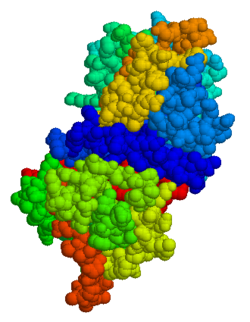C1-INH
C1-inhibitor (C1-inh, C1 esterase inhibitor) is a protease inhibitor belonging to the serpin superfamily. Its main function is the inhibition of the complement system to prevent spontaneous activation. C1-inhibitor is an acute-phase protein that circulates in blood at levels of around 0.25 g/L. The levels rise ~2-fold during inflammation. C1-inhibitor irreversibly binds to and inactivates C1r and C1s proteases in the C1 complex of classical pathway of complement. MASP-1 and MASP-2 proteases in MBL complexes of the lectin pathway are also inactivated. This way, C1-inhibitor prevents the proteolytic cleavage of later complement components C4 and C2 by C1 and MBL. Although named after its complement inhibitory activity, C1-inhibitor also inhibits proteases of the fibrinolytic, clotting, and kinin pathways. Note that C1-inhibitor is the most important physiological inhibitor of plasma kallikrein, fXIa, and fXIIa.
...
Wikipedia


